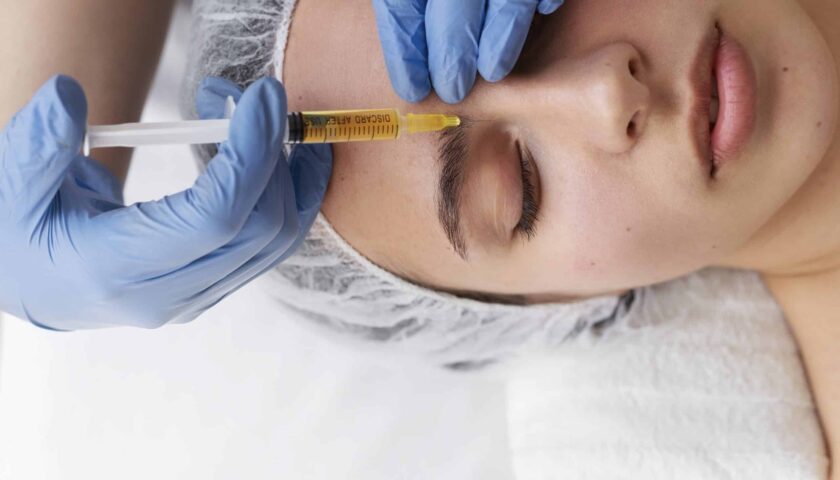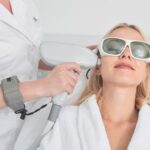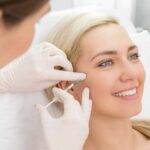
PRP facials are some of the most discussed treatments in recent years. They are also called “vampire” or “bloody” facials due to the peculiarities of the procedure.
The method involves injecting patients with a dose of their own blood under the skin, or rather, with processed blood plasma rich in platelets. Such plasma injections are performed in different areas of the body and head with various goals but according to the same principle.
What Is a PRP Facial?
PRP (autohemostimulation) is a unique system of rejuvenation based on the use of the body’s own resources. The essence of the technology is to activate cellular regeneration, which is triggered after the subcutaneous injection of the patient’s blood plasma. This procedure is considered one of the safest and gentle ones in cosmetology since foreign elements that can cause unwanted side effects do not enter the body.
Plasma contains trace elements necessary for the vital activities of the body. When the concentration of platelets in a plasma solution increases, the collagen and hyaluronic acid production process accelerate and become more intense.
The lack of these components leads to skin deterioration and noticeable signs of aging (wrinkles, pigment spots, grayish skin tone). The biostimulating properties of plasma enriched with platelets were the basis of a rejuvenation technique named plasma lifting.
Initially, the technique was used in maxillofacial surgery (for tissue regeneration) and trichology (for alopecia treatment). PRP has been practiced relatively recently in aesthetic medicine for rejuvenation, but the procedure’s high effectiveness led to its ever-growing popularity.
Plasma facials help to activate rejuvenating processes, improve complexion, accelerate metabolism at the cellular level, and stimulate cell division and blood vessel growth. They also promote the synthesis of collagen fibers, help membrane metabolism, and the production of intercellular substances.
Plasma beauty injections are one of the methods for combating premature aging and photoaging. The skin’s elasticity increases, its color improves, and not only the upper layers of the dermis but also the middle and even deep ones are healed. The process starts from the inside, which ensures the most noticeable result.
Based on the degree of cell damage and the initial condition of the skin, the doctor individually selects a course of PRP treatment for each client. To maintain the improved cell state, it is recommended to repeat the procedure at least once (preferably twice) a year.
How Do the PRP Facials Work?
Venous blood must be taken from the cubital fossa of the elbow joint of the patient before starting the procedure. The amount of blood may vary depending on the expected PRP effect and the area to be treated.
Rejuvenation with plasma is done after the blood is processed. First, the collected blood in a test tube is sent to a centrifuge, where it spins at a great speed and a specific angle. As a result, the blood is divided into red and white blood cells and the platelet part, which has the strongest effect.
A good blood composition (a high platelet content) is essential for the sessions to be successful. If the platelet concentration is reduced, the effect of PRP may be lower than expected.
Before starting the procedure, doing a blood test and stopping taking drugs that increase blood coagulation is necessary. The average treatment lasts three months and is carried out according to the scheme of one procedure in 10-14 days. A total of three to six procedures may be required to obtain the desired effect.
The length of a session depends on the size of the treated skin area. For example, PRP treatment for the face takes up to 30 minutes, together with the neck – up to 45 minutes, décolleté – up to 60 minutes, and the scalp – up to 30 minutes.
After the procedure, it is important to avoid rubbing the treated skin areas, getting them wet, or scratching them, and you should treat them with creams or lotions for 12 hours. It is forbidden to sunbathe or visit the tanning beds for 14 days. Swimming pools, hot baths, and saunas are prohibited for three days.
The treatment can be repeated one to two times per year. On an individual basis, the doctor can prescribe more frequent repetitions, for example, during the recovery period after laser procedures. This procedure can be combined with other product treatments, such as Ellanse, although first consulting with a specialist is recommended.
Who Is a Good Candidate for a PRP Facial?
PRP is used to preserve the skin’s youth, eliminate the first signs of aging and solve some aesthetic problems. Since the list of indications is quite extensive, the procedure can be performed on a range of patients who are at least 18 years old.
Indications for plasma facial treatment are:
- Age-related skin changes;
- Mimic wrinkles;
- Stretch marks, scars, and post-acne;
- Laxity of the skin;
- Dryness of the skin;
- Acne (blackheads);
- Pigmentation;
- Couperosis;
- Uneven relief and skin color.
Most often, PRP is used for aesthetic purposes, but sometimes it is recommended for treating acne and inflammatory rashes (though the patient should undergo an examination by a doctor to rule out any potential diseases that can cause such rashes first).
Also, PRP can prepare the skin for some cosmetology procedures and operations and accelerate recovery after them. In some cases, plasma injections are combined with other aesthetic procedures to obtain the maximum effect.
Plasma facial treatments have the same contraindications as any other invasive procedure:
- Oncology;
- Autoimmune diseases;
- Period of exacerbation of chronic diagnoses;
- Inflammation or mechanical damage to the skin in the affected area;
- Pregnancy and breastfeeding.
Some procedures include the patient’s own plasma and additional substances, such as hyaluronic acid and stabilizers. In this case, an allergic reaction is possible, but practice shows that this is an extremely rare occurrence.
How Long Do the Results of a PRP Facial Last?
Generally, the results can hold anywhere from a few months to over a year.
After the first treatment, there may be an immediate improvement in the skin’s texture and tone due to the activation of collagen production and increased blood flow. However, this initial improvement may subside after a few weeks as the swelling resolves.
Over time, as the PRP stimulates collagen production and promotes tissue regeneration, the facial treatment results become more noticeable. The skin may appear smoother, firmer, and more youthful. The duration of these effects can vary, but many individuals experience results lasting for several months.
Follow-up treatments are often recommended to maintain and prolong the benefits of a facial PRP. These can be scheduled every six to twelve months. Regular maintenance procedures can help sustain collagen production and the rejuvenating effects of PRP, ensuring longer-lasting results.
Individual responses to PRP may differ, and results can be influenced by factors like age, overall health, lifestyle habits, and skincare routine.
Additionally, combining PRP facial treatment with a comprehensive skincare regimen, sun protection, and a healthy lifestyle can improve the results and extend their duration.
PRP Facial Benefits and Risks
Like all cosmetic procedures, PRP also has some potential downsides to consider.
- Relative risks of plasma lifting;
- For an optimal outcome, several procedures must be carried out;
- Insufficient effectiveness for deep wrinkles, pronounced age changes, and pigment spots;
- The procedure can be painful (depending on individual sensitivity), but topical numbing agents can minimize any discomfort;
- Although rare, there is a small risk of infection at the injection sites. Therefore, ensuring that a qualified professional performs the procedure in a sterile environment is crucial;
- After the procedure, the skin may remain red and slightly swollen for several days.
The disadvantages of plasma lifting are quite tame considering that many procedures with a similar cosmetic effect have much more contraindications and risks of complications. PRP facials, due to the use of personal plasma, do not cause allergies (in rare cases, an allergy to the means used to prepare the plasma is possible) or produce any side effects.
Advantages of PRP:
- Healing and rejuvenation of the skin in a natural way via stimulating collagen production and promoting tissue regeneration;
- Safety of the procedure due to the use of the patient’s own plasma;
- Noticeable results are visible even after the first procedure;
- Improvement of skin condition after each procedure (there is a cumulative effect);
- Preservation of the result for up to two years or more (when conducting preventive sessions);
- Easy and short rehabilitation period;
- Compatibility with other cosmetic procedures, such as microneedling, to enhance their effectiveness and tailor the treatment to individual needs.
Conclusion
Plasma facial treatment offers a promising solution for patients seeking skin improvement. The benefits of PRP, such as skin rejuvenation, fine lines, and wrinkles reduction, improved skin tone and texture, and its natural and customizable nature, make it an appealing option for many. With proper care, PRP facial treatments can be a valuable tool in achieving healthier, rejuvenated skin.
FAQ
What does PRP do for the face?
Plasma injections for the face can stimulate collagen production, reduce the appearance of wrinkles and fine lines, improve skin tone and texture, and enhance overall skin rejuvenation.
PRP’s growth factors and bioactive proteins promote tissue repair and regeneration, producing a more youthful and radiant complexion.
PRP can also potentially improve acne scars, sun damage, and hyperpigmentation. Additionally, this procedure can be combined with other facial treatments, such as microneedling, to enhance their effectiveness and provide more comprehensive results.
How long does it take for a PRP facial to heal?
The healing time for a plasma treatment for the face can vary depending on individual factors and the extent of the treatment. Generally, it ranges from a few days to a week.
During this time, the patient may experience mild redness, swelling, and sensitivity in the treated area. These side effects are usually temporary and resolve on their own.
The complete healing process, including collagen production and skin rejuvenation, may take several weeks to a few months as the PRP stimulates natural tissue regeneration.
How often should you do PRP for your face?
The frequency of plasma facial treatments can vary depending on the patient’s individual factors, needs, and specific treatment goals but several series of PRP treatments are recommended for achieving optimal results.
At the beginning of the treatment, it is common to undergo three to four treatments spaced about four to six weeks apart. This order helps to kickstart the rejuvenation process and stimulate collagen production. After completing the initial series, maintenance treatments are typically performed every six to twelve months to sustain the achieved results.
References
Nanda, S., Chauhan, K., Shetty, V., Dashore, S., & Bhatia, S. (2021). Platelet-Rich Plasma in Aesthetics. Indian Dermatology Online Journal, 12(Suppl 1), S41. https://doi.org/10.4103/idoj.idoj_290_21
Alam, M., Hughart, R., Champlain, A., Geisler, A., Paghdal, K., Whiting, D., Hammel, J. A., Maisel, A., Rapcan, M. J., West, D. P., & Poon, E. (2018). Effect of Platelet-Rich Plasma Injection for Rejuvenation of Photoaged Facial Skin: A Randomized Clinical Trial. JAMA Dermatology, 154(12), 1447-1452. https://doi.org/10.1001/jamadermatol.2018.3977.
Yuksel EP, Sahin G, Aydin F, Senturk N, Turanli AY. Evaluation of effects of platelet-rich plasma on human facial skin. J Cosmet Laser Ther. 2014 Oct;16(5):206-8. doi: 10.3109/14764172.2014.949274. Epub 2014 Aug 25. PMID: 25065381.
Lei X, Xu P, Cheng B. Problems and Solutions for Platelet-Rich Plasma in Facial Rejuvenation: A Systematic Review. Aesthetic Plast Surg. 2019;43(2):457-469. doi:10.1007/s00266-018-1256-1.
Elnehrawy NY, Ibrahim ZA, Eltoukhy AM, Nagy HM. Assessment of the efficacy and safety of single platelet-rich plasma injection on different types and grades of facial wrinkles. J Cosmet Dermatol. 2017;16:103–11.
Injectable aesthetics are popular due to their ability to provide noticeable results with minimal downtime compared to surgical procedures. They are versatile and can be tailored to meet individual aesthetic goals, whether it's enhancing lips, restoring facial volume, or smoothing out wrinkles. However, they should always be administered by qualified professionals to ensure safety and achieve optimal results.
Injectable aesthetics are used to enhance facial features, reduce the signs of aging, and improve overall facial symmetry and appearance.
Key types of injectable aesthetics include:
-
Dermal Fillers: These injectables are used to add volume, fill in wrinkles and folds, and enhance facial contours. They often contain substances like hyaluronic acid, collagen, or calcium hydroxylapatite, which help plump up the skin and smooth out fine lines and wrinkles.
-
Botulinum Toxin (Botox): Botulinum toxin injections temporarily relax facial muscles that cause wrinkles and lines to form. It is commonly used to treat forehead lines, frown lines between the eyebrows, and crow's feet around the eyes.
-
Collagen Stimulators: These injectables stimulate the body's own collagen production, helping to improve skin texture and firmness over time. Examples include poly-L-lactic acid (Sculptra) and calcium hydroxylapatite (Radiesse).
-
Neurotoxin Injections: Besides Botox, other neurotoxins such as Dysport and Xeomin are used similarly to reduce wrinkles and lines.





